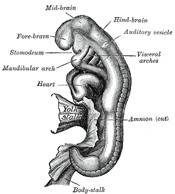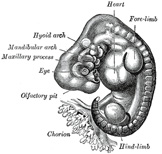
Second Week.—By the end of this week the ovum has increased considerably in size, and the majority of its villi are vascularized. The embryo has assumed a definite form, and its cephalic and caudal extremities are easily distinguished. The neural folds are partly united. The embryo is more completely separated from the yolk-sac, and the paraxial mesoderm is being divided into the primitive segments (Fig. 58).

Third Week.—By the end of the third week the embryo is strongly curved, and the primitive segments number about thirty. The primary divisions of the brain are visible, and the optic and auditory vesicles are formed. Four branchial grooves are present: the stomodeum is well-marked, and the bucco-pharyngeal membrane has disappeared. The rudiments of the limbs are seen as short buds, and the Wolffian bodies are visible (Fig. 59).
